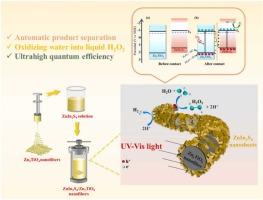富氧空位Z-Scheme ZnIn2S4/Zn2TiO4异质结纳米纤维用于纯水分解和自动产物分离
IF 6.3
2区 材料科学
Q2 CHEMISTRY, PHYSICAL
引用次数: 0
摘要
光催化纯水分解是解决能源和环境挑战的可行策略。然而,由于载流子分离效率低、常规产物的常规产物分离存在障碍,严重制约了纯水分解的实际应用。在本研究中,通过静电纺丝和水热法成功地在Zn2TiO4纳米纤维表面原位生长了ZnIn2S4纳米片,从而得到了ZnIn2S4/Zn2TiO4复合纳米纤维。光催化纯水分解实验表明,ZIS/ZTO-2纳米纤维的H2和H2O2析出率分别为774.3 μmol∙g-1∙h-1和89.0 μmol∙g-1∙h-1,分别是纯ZnIn2S4纳米纤维的5.2倍和5.4倍。光催化活性的显著增强主要是由于z型异质结的形成和氧空位的引入,有效地促进了光生载流子的分离和转移。此外,氧空位的存在选择性地将水氧化为H2O2,而不是通过光生成的孔,从而在光催化纯水分解过程中实现H2和H2O2的原位和自动分离。值得注意的是,ZIS/ZTO-2在390 nm波长处的表观量子效率达到19.66%。本工作为构建高效的光催化纯水分解产物自动分离光催化剂提供了研究基础。本文章由计算机程序翻译,如有差异,请以英文原文为准。

Oxygen vacancy-rich Z-scheme ZnIn2S4/Zn2TiO4 heterojunction nanofibers for pure water splitting with automatic product separation
Photocatalytic pure water splitting is a viable strategy to resolve energy and environmental challenges. However, the practical application of pure water splitting is significantly restricted by inefficient charge carrier separation and the obstacle in the separation of conventional products of conventional products. In this study, the in-situ growth of ZnIn2S4 nanosheets on the surface of Zn2TiO4 nanofibers is successfully achieved through electrospinning and hydrothermal methods, thereby, resulting in ZnIn2S4/Zn2TiO4 composite nanofibers. Photocatalytic pure water splitting experiments reveal that the ZIS/ZTO-2 nanofibers exhibit H2 and H2O2 evolution rates of 774.3 μmol∙g−1∙h−1 and 89.02 μmol∙g−1∙h−1, respectively, which are 5.2 times and 5.4 times higher than those of pure ZnIn2S4 nanosheets. The significant enhancement in photocatalytic activity is primarily attributed to the formation of Z-scheme heterojunction and the introduction of oxygen vacancies, which effectively promote the separation and transfer of photogenerated charge carriers. Additionally, the presence of oxygen vacancies selectively steers water oxidation toward H2O2 instead of O2 via photogenerated holes, enabling the in-situ and automatic separation of H2 and H2O2 during photocatalytic pure water splitting. Notably, ZIS/ZTO-2 achieves an apparent quantum efficiency of 19.66 % at a wavelength of 390 nm. This work provides a research foundation for constructing efficient photocatalysts for automatic product separation in photocatalytic pure water splitting.
求助全文
通过发布文献求助,成功后即可免费获取论文全文。
去求助
来源期刊

Journal of Alloys and Compounds
工程技术-材料科学:综合
CiteScore
11.10
自引率
14.50%
发文量
5146
审稿时长
67 days
期刊介绍:
The Journal of Alloys and Compounds is intended to serve as an international medium for the publication of work on solid materials comprising compounds as well as alloys. Its great strength lies in the diversity of discipline which it encompasses, drawing together results from materials science, solid-state chemistry and physics.
 求助内容:
求助内容: 应助结果提醒方式:
应助结果提醒方式:


